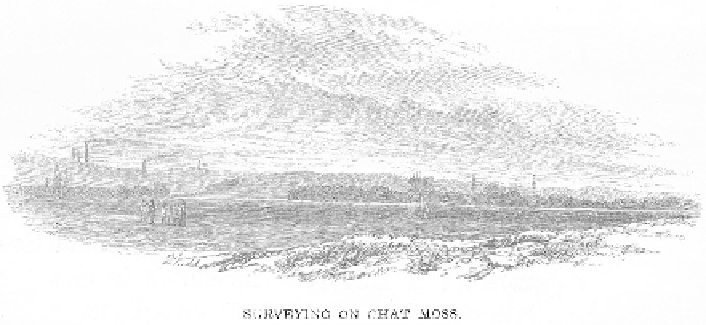Geography Reference
In-Depth Information
This would seem to suggest that Chat Moss as a place was not a thing of history, and if
we wanted to discern its historical standing then we would have to look elsewhere. This we
did with more research into the history of the building of the railway across Chat Moss. The
main source of information on the construction of the Liverpool to Manchester railway is
Samuel Smiles' 1864 publication,
The Lives of the Engineers
(re-published as Smiles, 1975).
The topic contains information on the vicissitudes of the line's construction, yet this written
information did little to advance the project. Rather like the objective facts of the original
story, it did little to excite the reader's imagination.
Instead the third insight was provided by a single small image from the topic, a vignette
line engraving that imagined the scene at the surveying of Chat Moss in the 1820s, which
once more unlocked a door leading to intuitive understanding. Our visit to Chat Moss itself
had been a quest to associate our historical understandings with a place in nature, which had
failed. Here, through this image on a page the intuition of Chat Moss's historical importance
became attached to an extant entity, a printed image on the page. Thus understanding is
developed through intentional acts of imagining based on a bodily given entity, the print.
Here we think it would be useful to analyse the nature of the print as an image and as an
extant thing, again through phenomenologically based research, in order to clarify the levels
at which they 'operate'.
The print as an image allows us to see something; seeing here is thought in two senses
of the word to see as optical sensing and to see in its phenomenological sense as 'simple
cognizance of what is found' (Heidegger, 1985, p. 39). This means being able to see what
the image is, in addition to its pictorial aspect, what it is as a thing. Examining the vignette
as a thing enables us to study it using categories that Heidegger develops in his
History of
the Concept of Time
.
Now we can understand it as: an environmental thing; a natural thing; and a picture thing.
Everything is both an environmental and a natural thing. The environmental thing is the
thing as it exists in the environmental contexture of our world, in this case as an image on
paper in a topic by Samuel Smiles on page 129 at the end of one chapter and prior to the
next that will deal with Chat Moss. The image is oval in shape with no frame; it fades off at
its edges off into the surrounding page. The thing's shape, size and pictorial nature tell us
that it is a vignette (Figure 12.4).
Figure 12.4
The vignette (Smiles, 1975, p. 129)








Search WWH ::

Custom Search